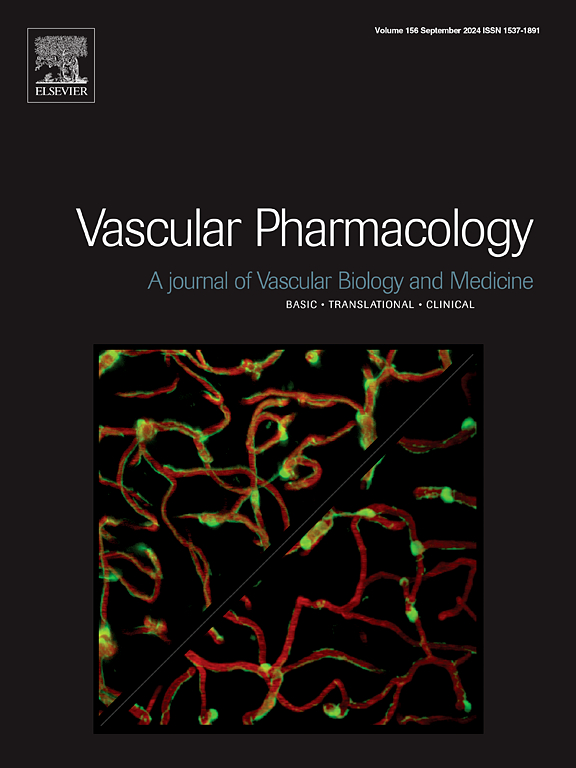Different gene expression patterns between mouse and human brain pericytes revealed by single-cell/nucleus RNA sequencing
IF 3.5
3区 医学
Q2 PHARMACOLOGY & PHARMACY
引用次数: 0
Abstract
Aims
Pericytes in the brain play important roles for microvascular physiology and pathology and are affected in neurological disorders and neurodegenerative diseases. Mouse models are often utilized for pathophysiology studies of the role of pericytes in disease; however, the translatability is unclear as brain pericytes from mouse and human have not been systematically compared. In this study, we investigate the similarities and differences of brain pericyte gene expression between mouse and human. Our analysis provides a comprehensive resource for translational studies of brain pericytes.
Methods
We integrated and compared four mouse and human adult brain pericyte single-cell/nucleus RNA-sequencing datasets derived using two single-cell RNA sequencing platforms: Smart-seq and 10x. Gene expression abundance and specificity were analyzed. Pericyte-specific/enriched genes were assigned by comparison with endothelial cells present in the same datasets, and mouse and human pericyte transcriptomes were subsequently compared to identify species-specific genes.
Results
An overall concordance between pericyte transcriptomes was found in both Smart-seq and 10x data. 206 orthologous genes were consistently differentially expressed between human and mouse from both platforms, 91 genes were specific/up-regulated in human and 115 in mouse. Gene ontology analysis revealed differences in transporter categories in mouse and human brain pericytes. Importantly, several genes implicated in human disease were expressed in human but not in mouse brain pericytes, including SLC6A1, CACNA2D3, and SLC20A2.
Conclusions
This study provides a systematic illustration of the similarities and differences between mouse and human adult brain pericytes.

单细胞/核RNA测序揭示小鼠和人类脑周细胞的不同基因表达模式
目的:脑周细胞在微血管生理和病理方面发挥着重要作用,并在神经系统疾病和神经退行性疾病中受到影响。小鼠模型常被用于病理生理学研究,以了解周细胞在疾病中的作用;然而,由于尚未对小鼠和人类的脑周细胞进行系统比较,因此其可转化性尚不明确。在这项研究中,我们调查了小鼠和人类脑周细胞基因表达的异同。我们的分析为脑周细胞的转化研究提供了全面的资源:我们整合并比较了使用两种单细胞 RNA 测序平台获得的四个小鼠和人类成人脑周细胞单细胞/核 RNA 测序数据集:Smart-seq 和 10×。对基因表达丰度和特异性进行了分析。通过与相同数据集中的内皮细胞进行比较,确定了周细胞特异性/富集基因,随后比较了小鼠和人类周细胞转录组,以确定物种特异性基因:结果:在Smart-seq和10×数据中发现了周细胞转录组之间的总体一致性。在这两个平台上,206个同源基因在人和小鼠之间有一致的差异表达,其中91个基因在人中特异/上调,115个基因在小鼠中特异/上调。基因本体分析显示,小鼠和人脑周细胞中的转运体类别存在差异。重要的是,一些与人类疾病有关的基因在人类脑周细胞中表达,而在小鼠脑周细胞中没有表达,包括SLC6A1、CACNA2D3和SLC20A2:这项研究系统地说明了小鼠和人类成体脑周细胞的异同。
本文章由计算机程序翻译,如有差异,请以英文原文为准。
求助全文
约1分钟内获得全文
求助全文
来源期刊

Vascular pharmacology
医学-药学
CiteScore
6.60
自引率
2.50%
发文量
153
审稿时长
31 days
期刊介绍:
Vascular Pharmacology publishes papers, which contains results of all aspects of biology and pharmacology of the vascular system.
Papers are encouraged in basic, translational and clinical aspects of Vascular Biology and Pharmacology, utilizing approaches ranging from molecular biology to integrative physiology. All papers are in English.
The Journal publishes review articles which include vascular aspects of thrombosis, inflammation, cell signalling, atherosclerosis, and lipid metabolism.
 求助内容:
求助内容: 应助结果提醒方式:
应助结果提醒方式:


